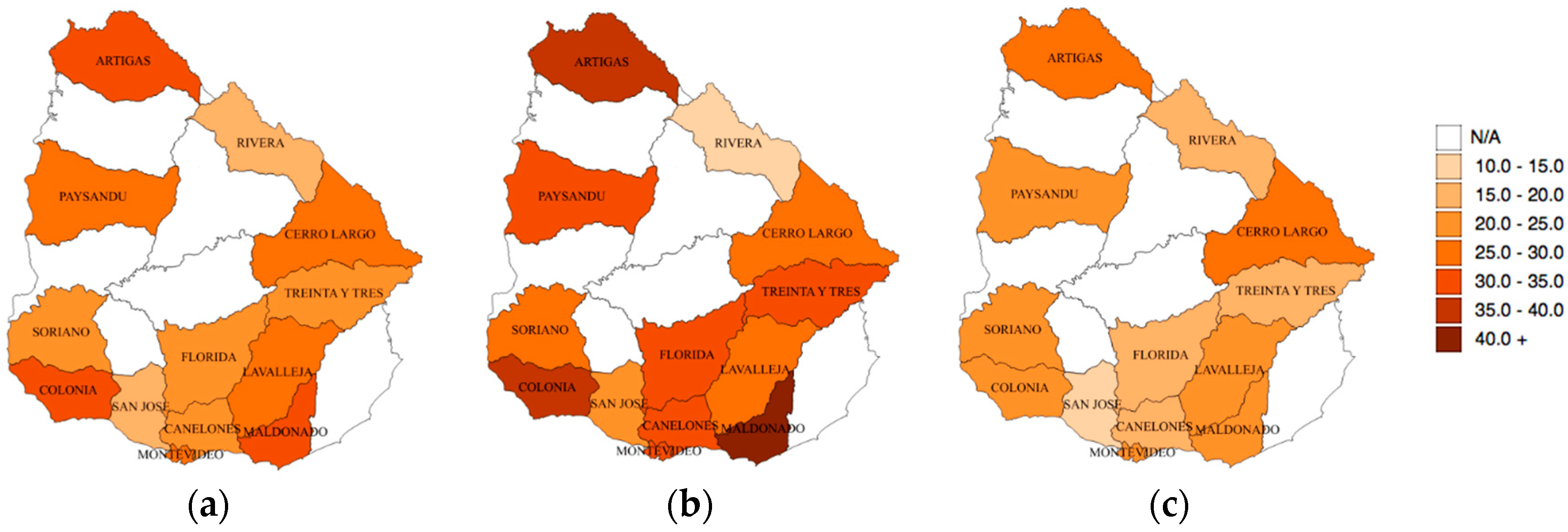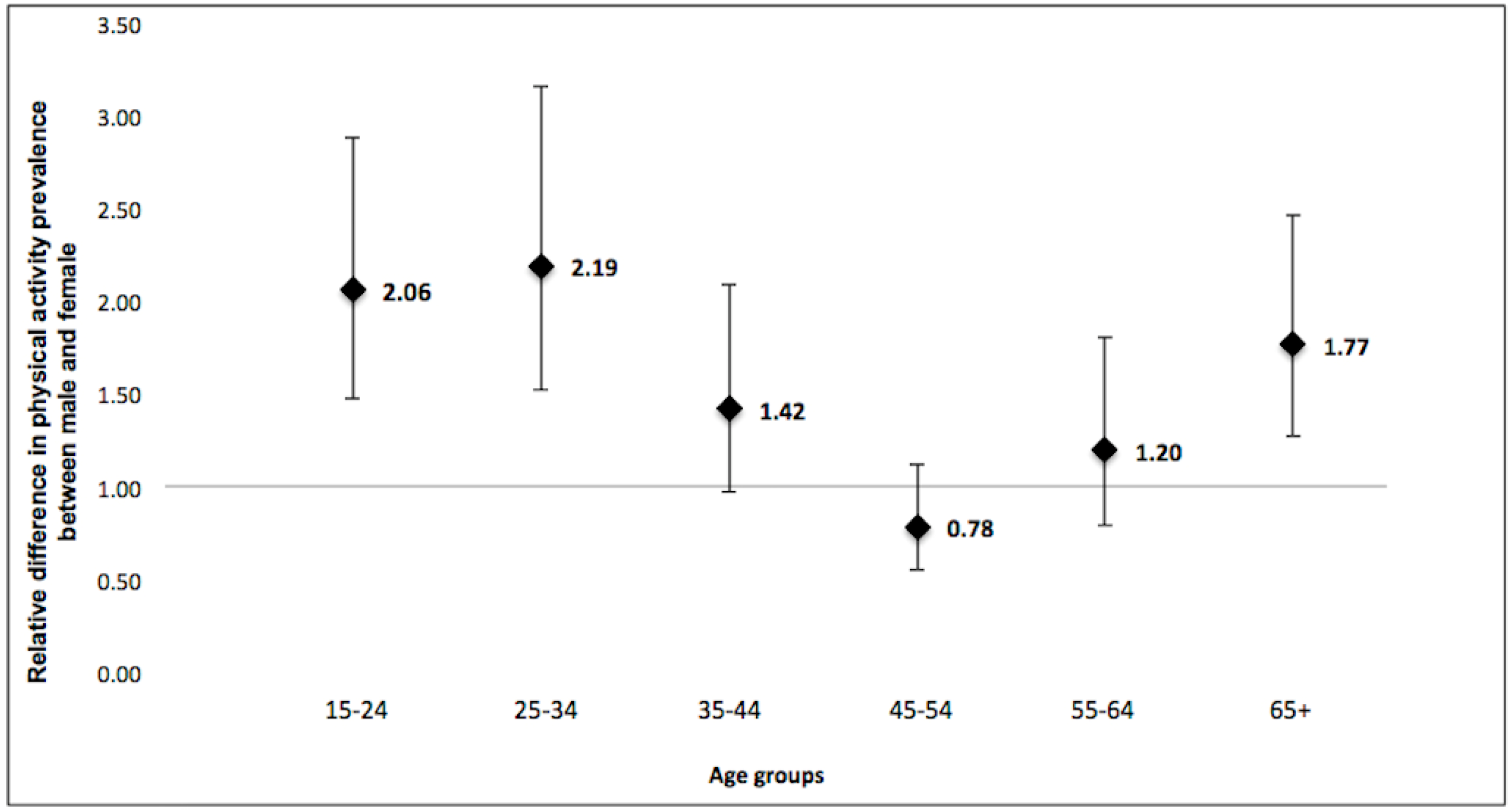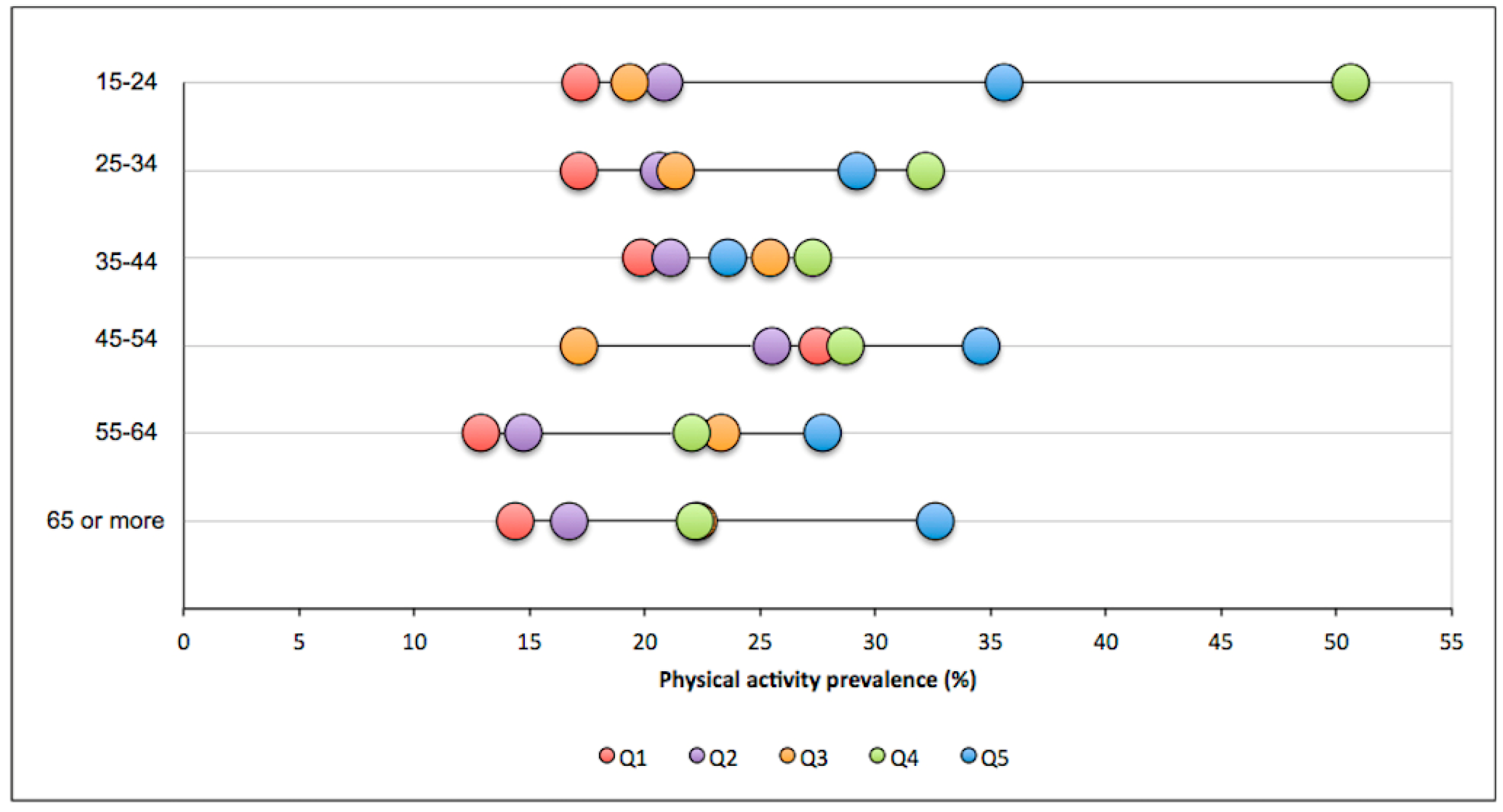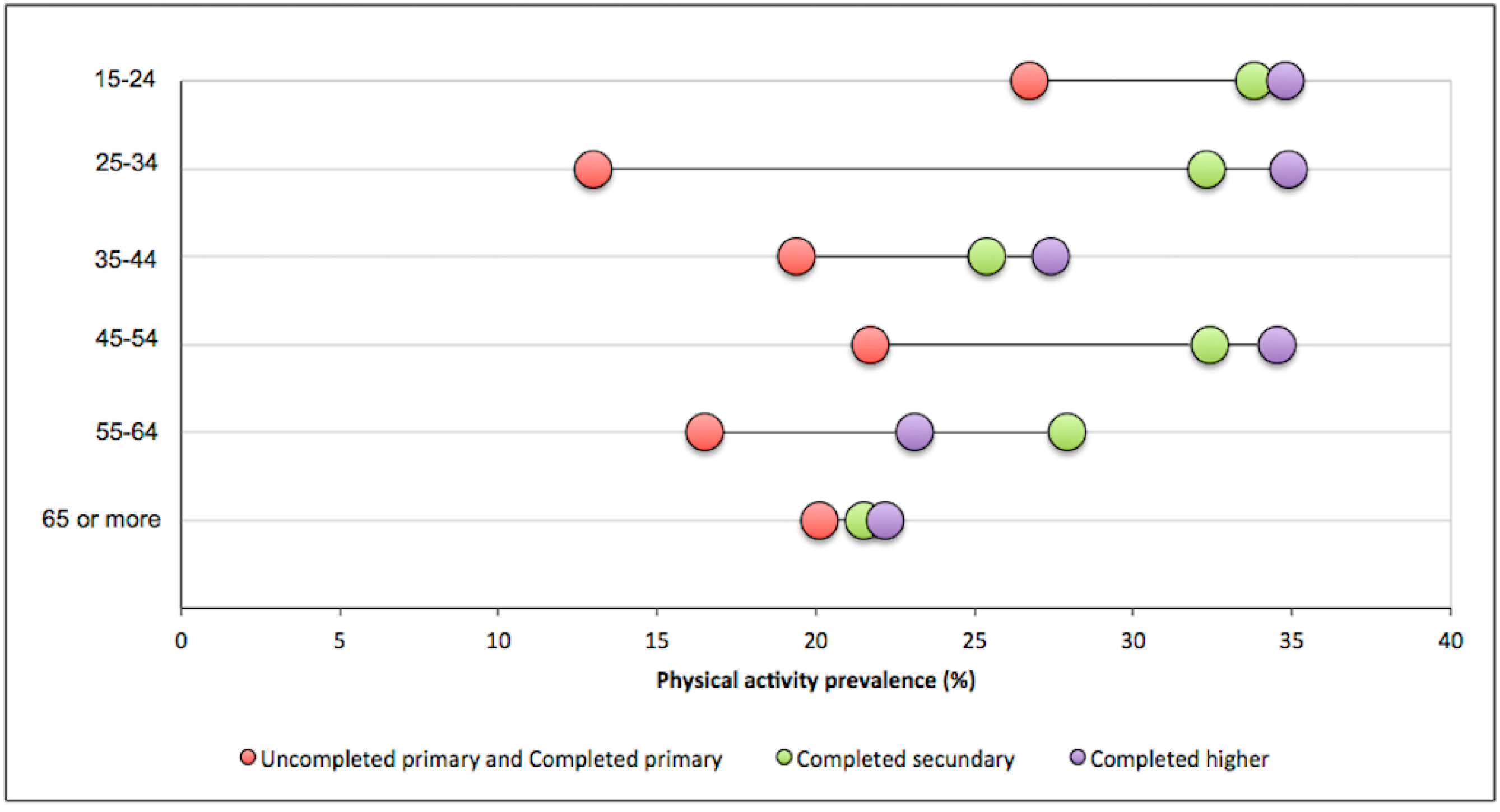Descriptive Epidemiology of Uruguayan Adults’ Leisure Time Physical Activity
Abstract
1. Introduction
2. Materials and Methods
3. Results
4. Discussion
5. Conclusions
Supplementary Materials
Author Contributions
Funding
Acknowledgments
Conflicts of Interest
References
- Caspersen, C.J.; Powell, K.E.; Christenson, G.M. Physical activity, exercise, and physical fitness: Definitions and distinctions for health-related research. Public Health Rep. 1985, 100, 126–131. [Google Scholar] [PubMed]
- Kyu, H.H.; Bachman, V.F.; Alexander, L.T.; Mumford, J.E.; Afshin, A.; Estep, K.; Veerman, J.L.; Delwiche, K.; Iannarone, M.L.; Moyer, M.L.; et al. Physical activity and risk of breast cancer, colon cancer, diabetes, ischemic heart disease, and ischemic stroke events: Systematic review and dose-response meta-analysis for the Global Burden of Disease Study 2013. BMJ 2016, 354, i3857. [Google Scholar] [CrossRef] [PubMed]
- Pedersen, B.K.; Saltin, B. Exercise as medicine—Evidence for prescribing exercise as therapy in 26 different chronic diseases. Scand. J. Med. Sci. Sports 2015, 25, 1–72. [Google Scholar] [CrossRef] [PubMed]
- Penedo, F.J.; Dahn, J.R. Exercise and well-being: A review of mental and physical health benefits associated with physical activity. Curr. Opin. Psychiatry 2005, 18, 189–193. [Google Scholar] [CrossRef] [PubMed]
- Lee, I.M.; Shiroma, E.J.; Lobelo, F.; Puska, P.; Blair, S.N.; Katzmarzyk, P.T.; Lancet Physical Activity Series Working Group. Effect of physical inactivity on major non-communicable diseases worldwide: An analysis of burden of disease and life expectancy. Lancet 2012, 380, 219–229. [Google Scholar] [CrossRef]
- Ding, D.; Lawson, K.D.; Kolbe-Alexander, T.L.; Finkelstein, E.A.; Katzmarzyk, P.T.; van Mechelen, W.; Pratt, M.; Lancet Physical Activity Series 2 Executive Committee. The economic burden of physical inactivity: A global analysis of major non-communicable diseases. Lancet 2016, 388, 1311–1324. [Google Scholar] [CrossRef]
- World Health Organization. Global Recommendations on Physical Activity for Health; World Health Organization: Geneva, Switzerland, 2010. [Google Scholar]
- Kohl, H.W., 3rd; Craig, C.L.; Lambert, E.V.; Inoue, S.; Alkandari, J.R.; Leetongin, G.; Kahlmeier, S.; Lancet Physical Activity Series Working Group. The pandemic of physical inactivity: Global action for public health. Lancet 2012, 380, 294–305. [Google Scholar] [CrossRef]
- Hallal, P.C.; Andersen, L.B.; Bull, F.C.; Guthold, R.; Haskell, W.; Ekelund, U.; Lancet Physical Activity Series Working Group. Global physical activity levels: Surveillance progress, pitfalls, and prospects. Lancet 2012, 380, 247–257. [Google Scholar] [CrossRef]
- Sallis, J.F.; Bull, F.; Guthold, R.; Heath, G.W.; Inoue, S.; Kelly, P.; Oyeyemi, A.L.; Perez, L.G.; Richards, J.; Hallal, P.C. Progress in physical activity over the Olympic quadrennium. Lancet 2016, 388, 1325–1336. [Google Scholar] [CrossRef]
- Ramírez Varela, A.; Pratt, M.; Powell, K.; Lee, I.M.; Bauman, A.; Heath, G.; Martins, R.C.; Kohl, H.; Hallal, P.C. Worldwide surveillance, policy, and research on physical activity and health: The global observatory for physical activity. J. Phys. Act. Health 2017, 14, 701–709. [Google Scholar] [CrossRef] [PubMed]
- Azevedo, M.R.; Araujo, C.L.; Reichert, F.F.; Siqueira, F.V.; da Silva, M.C.; Hallal, P.C. Gender differences in leisure-time physical activity. Int. J. Public Health 2007, 52, 8–15. [Google Scholar] [CrossRef] [PubMed]
- Pollard, T.M.; Wagnild, J.M. Gender differences in walking (for leisure, transport and in total) across adult life: A systematic review. BMC Public Health 2017, 17, 341. [Google Scholar] [CrossRef] [PubMed]
- Brown, W.J.; Mielke, G.I.; Kolbe-Alexander, T.L. Gender equality in sport for improved public health. Lancet 2016, 388, 1257–1258. [Google Scholar] [CrossRef]
- Azevedo, M.R.; Araujo, C.L.; Cozzensa da Silva, M.; Hallal, P.C. Tracking of physical activity from adolescence to adulthood: A population-based study. Rev. Saude Publica 2007, 41, 69–75. [Google Scholar] [CrossRef] [PubMed]
- Poggio, R.; Seron, P.; Calandrelli, M.; Ponzo, J.; Mores, N.; Matta, M.G.; Gutierrez, L.; Chung-Shiuan, C.; Lanas, F.; He, J.; et al. Prevalence, Patterns, and Correlates of Physical Activity Among the Adult Population in Latin America: Cross-Sectional Results from the CESCAS I Study. Glob. Heart 2016, 11, 81–88.e1. [Google Scholar] [CrossRef] [PubMed]
- Yu, C.-C.; Liaw, Y.-H.; Barnd, S. Cultural and social factors affecting women’s physical activity participation in Taiwan. Sport Educ. Soc. 2004, 9, 379–393. [Google Scholar] [CrossRef]
- Ng, M.; Fleming, T.; Robinson, M.; Thomson, B.; Graetz, N.; Margono, C.; Mullany, E.C.; Biryukov, S.; Abbafati, C.; Abera, S.F.; et al. Global, regional, and national prevalence of overweight and obesity in children and adults during 1980–2013: A systematic analysis for the Global Burden of Disease Study 2013. Lancet 2014, 384, 766–781. [Google Scholar] [CrossRef]
- Osuji, T.; Lovegreen, S.; Elliott, M.; Brownson, R.C. Barriers to Physical Activity Among Women in the Rural Midwest. Women Health 2006, 44, 41–55. [Google Scholar] [CrossRef] [PubMed]
- Eime, R.M.; Charity, M.J.; Harvey, J.T.; Payne, W.R. Participation in sport and physical activity: Associations with socio-economic status and geographical remoteness. BMC Public Health 2015, 15, 434. [Google Scholar] [CrossRef] [PubMed]
- Hallal, P.C.; Victora, C.G.; Wells, J.C.; Lima, R.C. Physical inactivity: Prevalence and associated variables in Brazilian adults. Med. Sci. Sports Exerc. 2003, 35, 1894–1900. [Google Scholar] [CrossRef] [PubMed]
- Celis-Morales, C.; Salas, C.; Alduhishy, A.; Sanzana, R.; Martinez, M.A.; Leiva, A.; Diaz, X.; Martinez, C.; Alvarez, C.; Leppe, J.; et al. Socio-demographic patterns of physical activity and sedentary behaviour in Chile: Results from the National Health Survey 2009–2010. J. Public Health 2016, 38, e98–e105. [Google Scholar] [CrossRef] [PubMed]
- Finger, J.D.; Tylleskar, T.; Lampert, T.; Mensink, G.B. Physical activity patterns and socioeconomic position: The German National Health Interview and Examination Survey 1998 (GNHIES98). BMC Public Health 2012, 12, 1079. [Google Scholar] [CrossRef] [PubMed]
- Prince, S.A.; Adamo, K.B.; Hamel, M.E.; Hardt, J.; Connor Gorber, S.; Tremblay, M. A comparison of direct versus self-report measures for assessing physical activity in adults: A systematic review. Int. J. Behav. Nutr. Phys. Act. 2008, 5, 56. [Google Scholar] [CrossRef] [PubMed]




| Variables | N | % | Low | Moderate | High |
|---|---|---|---|---|---|
| Sex | |||||
| Male | 1507 | 42.8 (40.7–44.9) | 49.4 (46.1–52.6) | 19.3 (16.9–22.1) | 31.3 (28.4–34.4) |
| Female | 2036 | 57.2 (55.1–59.4) | 62.9 (60.1–65.6) | 16.7 (14.8–18.9) | 20.4 (18.3–22.7) |
| Age groups | |||||
| 15–24 | 471 | 18.6 (16.7–20.5) | 48.1 (42.5–53.6) | 21.1 (16.9–26.1) | 30.9 (26.2–36.1) |
| 25–34 | 503 | 17.4 (15.8–19.2) | 59.6 (54.2–64.8) | 14.8 (11.5–18.9) | 25.6 (21.3–30.5) |
| 35–44 | 470 | 16.5 (14.9–18.3) | 58.7 (53.1–64.2) | 17.5 (13.6–22.1) | 23.8 (19.5–28.7) |
| 45–54 | 498 | 15.0 (13.6–16.6) | 53.6 (48.1–58.9) | 18.6 (14.7–23.2) | 27.9 (23.3–33.0) |
| 55–64 | 590 | 14.1 (12.8–15.5) | 63.5 (58.4–68.3) | 15.5 (12.3–19.3) | 21.1 (17.1–25.7) |
| 65+ | 1011 | 18.4 (17.0–19.8) | 60.5 (56.5–64.3) | 18.9 (16.1–22.2) | 20.6 (17.4–24.2) |
| Socioeconomic status | |||||
| Q1 (poorest) | 715 | 15.3 (13.9–16.9) | 69.45 (64.4–74.1) | 13.05 (10.0–16.8) | 17.5 (13.8–22.0) |
| Q2 | 699 | 17.1 (15.6–18.8) | 60.38 (55.3–65.2) | 20.08 (16.3–24.5) | 19.55 (15.8–24.0) |
| Q3 | 728 | 20.4 (18.7–22.2) | 60.79 (56.2–65.2) | 17.82 (14.7–21.5) | 21.39 (17.9–25.4) |
| Q4 | 698 | 22.7 (20.9–24.6) | 53.92 (49.3–58.5) | 13.95 (11.1–17.4) | 32.13 (28.0–36.5) |
| Q5 (wealthiest) | 703 | 24.5 (22.6–26.4) | 46.92 (42.5–51.4) | 22.85 (19.4–26.8) | 30.23 (26.4–34.3) |
| Educational level | |||||
| Uncompleted primary | 69 | 1.6 (1.1–2.2) | 71.9 (54.4–84.6) | 17.1 (7.3–35.2) | 11.0 (4.3–25.4) |
| Completed primary | 1784 | 46.5 (44.4–48.7) | 65.6 (62.5–68.5) | 14.3 (12.3–16.6) | 20.1 (17.6–22.9) |
| Completed secondary | 981 | 29.3 (27.4–31.3) | 53.6 (49.7–57.5) | 17.0 (14.2–20.1) | 29.4 (26.0–33.0) |
| Completed higher | 709 | 22.6 (20.9–24.4) | 43.2 (38.8–47.7) | 26.2 (22.4–30.4) | 30.6 (26.8–34.7) |
| Total | 3543 | N/A | 57.1 (54.0–60.3) | 17.8 (16.3–19.5) | 25.1 (23.3–27.0) |
© 2018 by the authors. Licensee MDPI, Basel, Switzerland. This article is an open access article distributed under the terms and conditions of the Creative Commons Attribution (CC BY) license (http://creativecommons.org/licenses/by/4.0/).
Share and Cite
Brazo-Sayavera, J.; Mielke, G.I.; Olivares, P.R.; Jahnecka, L.; Crochemore M. Silva, I. Descriptive Epidemiology of Uruguayan Adults’ Leisure Time Physical Activity. Int. J. Environ. Res. Public Health 2018, 15, 1387. https://doi.org/10.3390/ijerph15071387
Brazo-Sayavera J, Mielke GI, Olivares PR, Jahnecka L, Crochemore M. Silva I. Descriptive Epidemiology of Uruguayan Adults’ Leisure Time Physical Activity. International Journal of Environmental Research and Public Health. 2018; 15(7):1387. https://doi.org/10.3390/ijerph15071387
Chicago/Turabian StyleBrazo-Sayavera, Javier, Gregore I. Mielke, Pedro R. Olivares, Luciano Jahnecka, and Inacio Crochemore M. Silva. 2018. "Descriptive Epidemiology of Uruguayan Adults’ Leisure Time Physical Activity" International Journal of Environmental Research and Public Health 15, no. 7: 1387. https://doi.org/10.3390/ijerph15071387
APA StyleBrazo-Sayavera, J., Mielke, G. I., Olivares, P. R., Jahnecka, L., & Crochemore M. Silva, I. (2018). Descriptive Epidemiology of Uruguayan Adults’ Leisure Time Physical Activity. International Journal of Environmental Research and Public Health, 15(7), 1387. https://doi.org/10.3390/ijerph15071387





